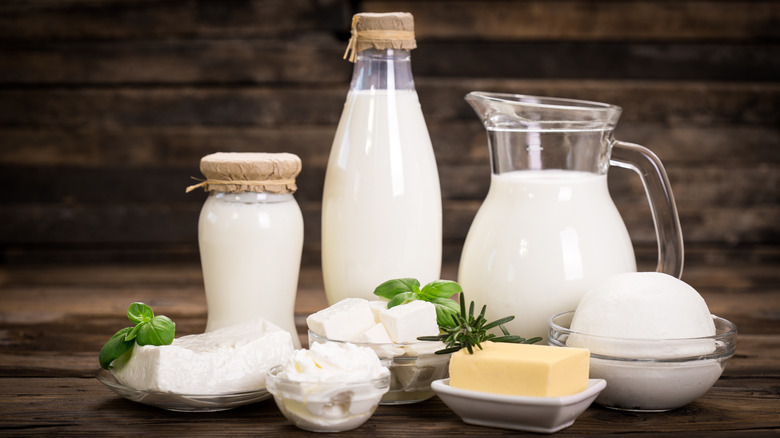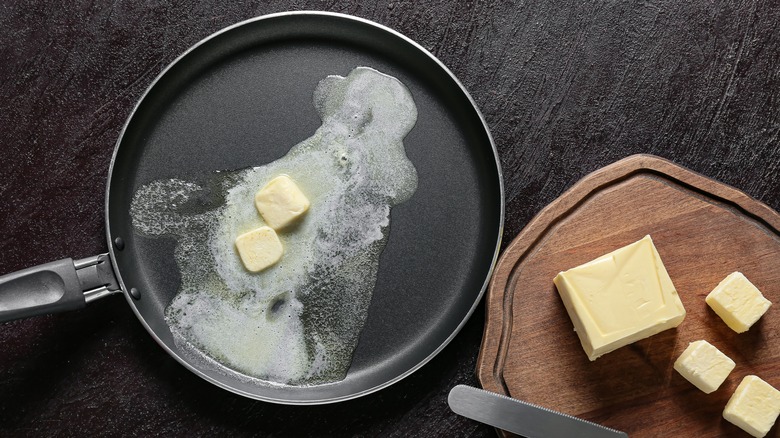The One Ingredient That Transforms Milk Into Half And Half
Whether craving a splash of half and half in your morning coffee or needing it to make rich, creamy desserts, it's a tragic kitchen moment when that cute little carton is missing in action. Half and half dairy deliciousness is simply irreplaceable –– or is it? The taste and creamy consistency is indeed like no other, but if you find yourself wanting on any given day, there's actually something you can do about it.
Compensating for a lack of half and half involves milk and a prominent refrigerator occupant that most chefs use on a consistent basis. It hails from the same fresh-dairy family as half and half, and there's a good chance you can pull it right out of your magic chef's hat in less than a minute. That would be butter, the real kind, which is likely hanging out in the door of your fridge in the shape of slim sticks or chunky blocks. And yes, this is the same ingredient that turns milk into cream.
It's not that you're replacing half and half, per se, but more like creating your own version of it. With butter, you can transform whole or low-fat milk into half and half within a handful of minutes. In a nutshell, simply add about a tablespoon of butter for every cup of milk. Presto! Half and half.
Creating half and half with butter magic
To transform milk into half and half, you really do just need two ingredients: your milk and a thick slice of butter. Ratios are important, as you don't want to be drinking butter, just using it to thicken the milk. To make the two combine for a higher creamy purpose, it takes a tablespoon of melted unsalted butter and almost a full cup of milk. The "almost" is crucial for the delicate balance. To make a cup of half and half, melt the tablespoon of butter in a measuring container and add milk until it reaches the one-cup mark.
If you prefer more precise measurements, the exact substitute is one tablespoon of butter and ⅞ cup of milk. When mixed well, you'll have an excellent substitute for the half and half in your recipes. Make sure the butter is real, not margarine or a reduced-fat. You'll need the butterfat for the half and half incarnation. Likewise, whole milk is ideal — though the trick does work with skim milk, albeit with a slightly thinner result. Avoid salted butter if possible so that it won't affect the taste or composition.
Your new butter-milk concoction may not be a perfect half and half substitute as far as consistency, especially when pouring it directly into hot coffee or tea. But it works just fine for sauces, alfredo pasta dishes, mixing into mashed potatoes, and creaming up puddings, your homemade vanilla ice cream, or baked goods.
Other options for half and half replacement
It's true that butter is the ultimate solo wiz-kid for transforming milk into half and half. But there are a few other options that would get you close in consistency and taste if necessary.
First up is cornstarch, which is commonly used to thicken sauces. It happens to work with milk as well — though it won't add the extra dairy essence that butter does. But thickness is what especially matters when using half and half in dessert or quick bread recipes, so cornstarch works just fine. Simply thicken a cup of milk with about a tablespoon of cornstarch. If you add too much, you end up with a mixture that's more like heavy whipping cream.
Another dry alternative is powdered heavy cream, which is similar to powdered milk but more dense. In this case, water is better than milk, and you'll need about ½ cup of powdered heavy cream per one cup of water.
Then there are the other thick or concentrated liquid milk products you can thin out to create half and half, namely evaporated milk and heavy whipping cream. Experiment with each to find what works for your tastes and in specific recipes. Unless you want a super sweet sauce or cup of coffee, you'll probably want to avoid condensed milk. It would take a lot of effort to break down the gooey (but delicious) thickness of condensed milk and reduce its 45% sugar content.



